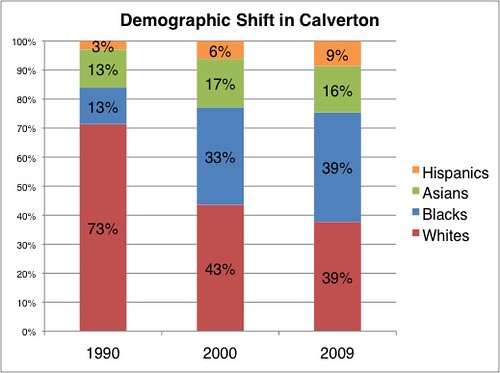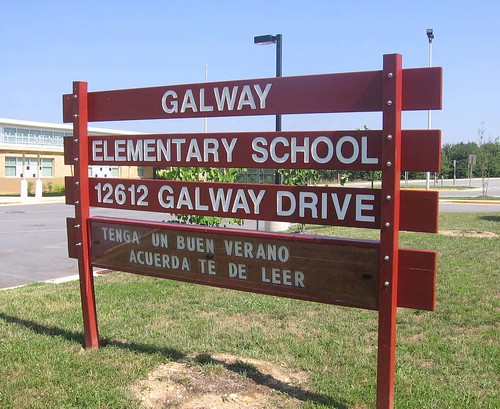Last year, Montgomery County became majority-minority for the first time. But our neighborhoods aren't as integrated as they could be, threatening the county's ability to grow and prosper.
On Sunday, the Post featured a cover story on newly-diverse suburban neighborhoods across the United States, focusing on the Hillandale neighborhood of Silver Spring:

Yet as Montgomery County becomes more polyglot, it's not necessarily integrated. Two years ago, my brother graduated from Galway Elementary School in Calverton. Its nearly 800 students are half black, a quarter Hispanic and just 4.3 percent white. In a neighborhood where the median household income is $76,000 a year and the average home sells for nearly $400,000, 60 percent of students are on free or reduced lunch. In addition, test scores are generally lower than they are at elementary schools elsewhere in the county.

On Sunday, the Post featured a cover story on newly-diverse suburban neighborhoods across the United States, focusing on the Hillandale neighborhood of Silver Spring:
From one end of McGovern Drive to the other, and on adjacent streets, a boundless diversity continues: immigrants, or their offspring, from Jamaica and Haiti, Egypt and Israel; African Americans who have lived there for 20 years; and whites who bought their homes when Lyndon Johnson was president.Since 1999, my family's lived in Calverton, which like Hillandale a few miles away was until recently a predominantly-white community. In 1990, whites made up almost three-fourths of Calverton's roughly 11,000 residents. Though the neighborhood has grown by more than half since then, whites and blacks make up equal shares of its population, at about 39 percent each. The Asian population's been steady, but the Hispanic contingent has tripled to become one-tenth of the community. Check out this graph (it may not add up to 100% because Hispanics are counted as an ethnicity, not a race):

Yet as Montgomery County becomes more polyglot, it's not necessarily integrated. Two years ago, my brother graduated from Galway Elementary School in Calverton. Its nearly 800 students are half black, a quarter Hispanic and just 4.3 percent white. In a neighborhood where the median household income is $76,000 a year and the average home sells for nearly $400,000, 60 percent of students are on free or reduced lunch. In addition, test scores are generally lower than they are at elementary schools elsewhere in the county.

Where are Calverton's white and middle-class residents? Some of our neighbors have moved away to Rockville or Olney, which are generally more affluent and have higher-rated public schools. Those who remained chose to "opt out" of the system, putting their kids in private school. They also take part in other exclusive amenities, like the members-only Calverton Swim Club across the street from Galway. A quick look at the club's website reveals a mirror image of the school:

This isn't necessarily a problem for our family. My parents are very involved in my brother's education and are generally happy with his experience at Galway and now at Briggs Chaney Middle School, which is slightly more diverse. While my family aren't members of the Calverton Swim Club, we can go to the nicer and public Martin Luther King, Jr. Pool, which has water slides and a lazy river.
At the same time, it's generally recognized that the United States will cease to be a predominantly-white nation in about thirty years, and we're seeing the beginnings of that in Montgomery County. This actually puts us in the catbird seat: if we're going to compete in a global society, we must be able to understand and react to cultural differences. Your kids might be having birthday parties with Salvadorian, Iranian and Korean kids today, but they're preparing themselves to do business with people from those countries in the future.
Montgomery County has the ability to use its polyglot population as a strength, to create better, unified communities and draw investment and ideas from around the world. Yet it's frequently thwarted when more fortunate residents try to keep the less privileged out or, as in Calverton, "opt out" of the community altogether.
For years, the Columbia Country Club and the Town of Chevy Chase has fought to keep the Purple Line out of their community. A community group in Silver Spring tried to remove a soccer field in a local park because Hispanic teams from outside the neighborhood were using it. And neighbors in Bethesda had a vacant home demolished rather than letting a homeless family live there. These actions may benefit a small minority, but in the end, they hurt everyone.
This county's long had a reputation for progressive politics due to our affordable housing program and agricultural preserve. As a result, we tend to take diversity for granted, assuming that having Hispanic Heritage Month each October or occasionally eating ethnic food in Wheaton is enough. (Meanwhile, some are afraid to eat in Wheaton at all.) But this isn't enough. In order to fully take advantage of the county's diversity, and to ensure that everyone has a place here, we have to create truly integrated communities.
How can we do this?
We have to work even harder to create an equitable school system, ensuring students in affluent "Green Zone" schools and struggling "Red Zone" schools get the same level of education. Meanwhile, we have to continue investing in older communities like Silver Spring where "Red Zone" schools are located to give people the option of staying rather than moving further out and self-segregating.
We have to create neighborhoods that are accessible to a broad swath of the population, by providing a mix of housing styles and prices. In addition, we have to make it safer and easier to get around by foot, by bike and by public transit, which benefit all residents, not just those who can afford a car. And we have to make everyone feel welcome here, instead of scapegoating immigrants or teenagers.
Most importantly, we have to have the political wherewithal to do these things, rather than capitulate to groups who fight to preserve the status quo.
It's been a long time since Montgomery County was the "perfect suburbia," and it's not always clear what we'll become. Nonetheless, we have the opportunity to become something even greater. It won't be easy, but if we want to ensure the county's continued prosperity, we don't have a choice.


5 comments:
This post hit on some issues we're having in our own community over a elementary school boundary change:
http://www.montgomeryschoolsmd.org/departments/planning/pdf/BCC_MS2_SiteSelectionFinalReport.pdf
The school board debating whether or not to agree with the proposal this week & next.
I decided to examine the changes in free & reduced meals (FARMS) students at each school since it's a good single measure of income inequality.
For my neighborhood's own situation, despite other options that kept or increased diversity, the Superintendant's recommendation is going to remove some of the few remaining free & reduced meals (FARMS) students from Bethesda ES in a push towards making it more of a neighborhood school. Rosemary Hills ES is currently 19% FARMS & will become 22.2% while Bethesda ES is currently 6.6% FARMS and will become 3.3%. What's amazing is that these numbers are just a snapshot of the current year. Going back only 5 years to 2006, the schools each had 13.9% and 14% FARMS students.
Seeing this, I decided to look at all MCPS elementary schools to understand whether these two schools were outliers. They weren't. While we expect the percent of FARMS students to go up in the current economic climate, I was surprised to find that, in 25 of the county's 129-131 elementary schools (19%), including Bethesda ES, there was a decrease in the number of FARMS students from 2007-2011. 18 of those 25 schools (72%) with decreasing numbers of FARMS students already had 15% or fewer FARMS students in 2007, while overall, only 35% of our elementary schools had 15% or fewer FARMS students. This means over the past few years, we are seeing a county-wide trend of poverty being concentrated in fewer and fewer elementary schools.
Your brother's experiences in Galaway are not unique to that school. Here is percentage of FARM students at Galaway from 2004-2011: 36.6, 39.7, 38.5, 43.3, 46.2, 48.3, 51, 54.2. That trend of a 2.5% increase per year might seem large, but there are 16 of the 131 MCPS schools that show larger increases over that period. Of those 16, the lowest year 2004 % of FARMS students was 22.% FARMS in Burtonsville ES (44% FARMS in 2011).
Regardless of what MCPS says about pushing economic diversity in schools, the data seems to be showing a trend that is very much in the opposite direction.
I'd be glad to share my spreadsheets if you are interested.
Great article.
The article makes some good points but what is the soccer field to which you are referring, because I think you may be referring to something that was alleged by one side in the dispute, but never proven as fact.
Let me clarify your comment about the soccer field, "A community group in Silver Spring tried to remove a soccer field in a local park because Hispanic teams from outside the neighborhood were using it."
I am part of that group that opposes the soccer field... we have been fighting for 5 years against Parks and Planning and not because we oppose hispanic teams coming to our neighborhood... we oppose spending $5 million dollars to tear apart our existing soccer field to built a massive one in an area where more leisure parks and family activities are needed... We believe that the money can be use to maintain the neglected 11 soccer fields that already exist in the area, which MOCo has a hard time keeping in good condition... Even though We HISPANICS love futbol(soccer), we have also more pressing needs like education, social services and leisure family activities that can go a long way with 5 million dollars...and what's incredible is that Parks and Planning still has this plan in its budget while the county is cutting spending in crucial areas that affect specially the vulnerable folks of our communities...
Sorry for the rambling but I couldn't let people be misinformed by a government agency with a bias point of view and way to much time in their hands to justify their existence...
Alex Beltran
(Colombiano)
@D
Maintaining our own little local caste system is very hard work, and requires lots of expensive studies, data, and consultants.
Post a Comment